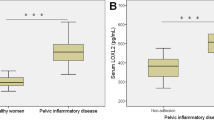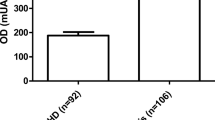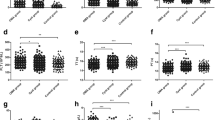Abstract
The concentrations of the specific activators (u-PA and t-PA) and the specific inhibitors (PAI-1 and PAI-2) of the fibrinolytic system were analyzed in the peritoneal fluid in women suffering from intra-abdominal adhesions, endometriosis or pelvic inflammatory diseases (PID). Peritoneal fluids were collected from ten women in whom a laparotomy was performed and an additional 108 in whom a laparoscopy was carried out. In comparison with the normal control patients all activators and inhibitors were significantly increased in cases of PID and when a second-look laparoscopy was performed one week after laparotomy with adhesiolysis. At laparoscopies, when adhesions were verified, u-PA in the peritoneal fluid was significantly increased and in cases of endometriosis PAI-2 was significantly reduced. The start of a laparotomy in order to remove adhesions, initiates a process, resulting in a significant increase of PAI-2 antigen in the pelvic fluid. The results imply that the fibrinolytic system is comprehensively activated in the peritoneal cavity during ongoing inflammatory reaction, and after adhesiolysis. The increase in plasminogen activators in the peritoneal fluid in established cases of pelvic adhesions or endometriosis may indicate that the fibrinolytic system is continuously active to inhibit the further formation of adhesions.
Similar content being viewed by others
REFERENCES
Ellis, H. 1971. The cause and prevention of postoperative adhesions. Surg. Gynaecol. 133:497–511.
Lalos, O. 1988. Risk factors for tubal infertility among infertile and fertile women. Eur. J. Obstet, Gynecol. Reprod. Biol. 29:129–136.
Laatikainen, T. J., A. K. Tenhunen, P. K. Venesmaa, and D. L. Apter. 1988. Factors influencing the success of microsurgery for distal tubal occlusion. Arch. Gynecol. Obstet. 243:101–106.
Boer-Meisel, M. E., E. R. te Velde, J. D. F. Habbema, and J. W. P. F. Kardaun. 1986. Predicting the pregnancy outcome in patients treated for hydrosalpinx: a prospective study. Fertil. Steril. 45:23–29.
Syrop, C. H., and J. Halme. 1987. Peritoneal fluid environment and infertility. Fertil. Steril. 48:1.
Rubin, J., G. A. Herrera, and D. Collins. 1991. An autopsy study of the peritoneal cavity from patients on continuous ambulatory peritoneal dialysis. Am. J. Kidney Dis. 18:97–102.
The American Fertility Society. 1985. Revised American Fertility Classification of endometriosis: Fertil. Steril. 43:351–352.
Buckman, R. F., M. Woods, L. Sargent, and A. S. Gervin. 1976. A unifying Pathogenic Mechanism in the Etiology of Intraperitoneal Adhesions. J. Surg. Research. 20:1–5.
O'Leary, D. P., and J. B. Coakley. 1992. The influence of suturing and sepsis on the development of postoperative adhesions. Ann. R. Coll. Surg. Engl. 74:134–137.
Holmdahl, L. 1994. Fibrinolysis and Adhesions, Dissertation from the Department of Surgery, University of Göteborg, Sweden.
Thejls, H., G. Heimer, J. Gnarpe, G. Larsson, Ö, Lundkvist, and A. Victor, 1991. Diagnosis and prevalence of persistent Chlamydia infection in infertile women: Tissue culture, direct antigen detection and serology. Fertile. Steril. 55:304–310.
Edelstam, G. Infertility and Pelvic Adhesions. 1994. Doctoral dissertation from the Faculty of Medicine, Uppsala University, Uppsala, Sweden.
Patton, D. L., M. Askienazy-Elbhar, J. Henry-Suchet, L. A. Campbell, A. Cappuccio, W. Tannous, S. Wang, and C. Kuo. 1994. Detection of Chlamydia trachomatis in fallopian tube tissue in women with postinfectious tubal infertility. Am. J. Obstet. Gynecol. 171:95–101.
Bouckart, P. X. J. M., J. A. Land, E. J. P. Brommer, J. J. Emeis, and J. L. H. Evers. 1990. The impact of peritoneal trauma on intra-abdominal fibrinolytic activity, adhesions formation and early embryonic development in a rabbit longitudinal model. Hum. Reprod. 5:237–241.
Batzofin, J. H., S. D. Holmes, W. E. Gibbons, and V. C. Buttram. 1985. Peritoneal fluid plasminogen activator activity in endometriosis and pelvic adhesive disease. Fertil. Steril. 44:277–279.
DÖrr, P. J., E. J. P. Brommer, G. Dooijewaard, and H. M. Wemer. 1993. Parameters of Fibrinolysis in peritoneal fluid and plasma in different stages of the menstrual cycle. Thrombosis and Haemostasis. 70:873–875.
Edelstam, G. A. B., Ö. E. Lundkvist, P. Venge, and T. C. Laurent: 1994. Hyaluronan and myeloperoxidase in the peritoneal fluid during genital inflammation. Inflammation. 18:13–21.
Grinnell, F., M. Milam, and P. A. Srere. 1972. Studies on cell adhesion. Arch. Biochem. Biophys. 153:193–198.
Lecander, I., and B. Åstedt. 1987. Specific plasminogen activator inhibitor of placental type PAI-2 occurring in amniotic fluid and cord blood. J. Lab. Clin. Med. 110:602–605.
Colton, T. 1974. Nonparametric methods. In: Colton T. Statistics in medicine. Little, Brown and Company. Boston, Massachusetts. pp 219–227.
DiZerega, G. S. 1994. Contemporary adhesions prevention. Fertil. Steril. 61:219–235.
Pijlman, B. M., P. J. DÖrr, E. J. P. Brommer, and H. M. Vemer. 1994. Prevention of adhesions. Eur. J. Obstet. Gynecol. Reprod. Biol. 53:155–163.
Gauwerky, J. H. F., J. Mann, and G. Bastert. 1990. The effect of fibrin glue and peritoneal graft in the prevention of intraperitoneal tissue. Arch. Gynecol. Obstst. 247:161–166.
Monk, B. J., M. L. Berman, and F. J. Montz. 1994. Adhesions after extensive gynecologic surgery, clinical significance, etiology and prevention. Am. J. Obstet. and Gynecol. 170:1396–1403.
Menzies, D., and H. Ellis. 1989. Intra-abdominal adhesions and their prevention by topical tissue plasminogen activator. J. Royal. Soc. Medicine. 82:534–535.
DÖrr, P. J., H. M. Vemer, E. J. Brommer, W. N. Willemsen, R. W. Veldhizen, and R. Rolland. 1990. Prevention of postoperative adhesions by tissue-type plasminogen activator (t-PA) in the rabbit. Eur. J. Obstet. Gyn. Reprod. Biol. 37:287–291.
Holmdahl, L. The role of fibrinolysis in adhesion formation. 1997. Eur. J. Surg. 577:24–31.
Evans, D. M., K. McAree, D. P. Guyton, N. Hawkins and K. Stakleff. 1993. Dose dependency and wound healing aspects of the use of tissue plasminogen activator in the prevention of intraabdominal adhesions. Am. J. Surg. 165:229–232.
Edelstam, G. A. B. and A. Karlsson-Parra. 1996. The human leucocyte antigen (HLA) DR expression and the distribution of T-lymphocytes in the fimbriae of the normal fallopian tube and during pelvic adhesion disease. Am. J. Reprod. Immunol. 35:471–476.
Åstedt, B., and F. NordenskjÖld. 1984. Plasminogen Activators in Endometriosis. Acta Obstet. Gyn. Scand. 123:23–24.
Scott-Coombes, D., S. Whawell, M. N. Vipond, and J. Thompson. 1995. Human intraperitoneal fibrinolytic response to elective surgery. Br. J. Surg. 82:414–417.
Author information
Authors and Affiliations
Rights and permissions
About this article
Cite this article
Edelstam, G., Lecander, I., Larsson, B. et al. Fibrinolysis in the Peritoneal Fluid During Adhesions, Endometriosis and Ongoing Pelvic Inflammatory Disease. Inflammation 22, 341–351 (1998). https://doi.org/10.1023/A:1022322814288
Issue Date:
DOI: https://doi.org/10.1023/A:1022322814288




